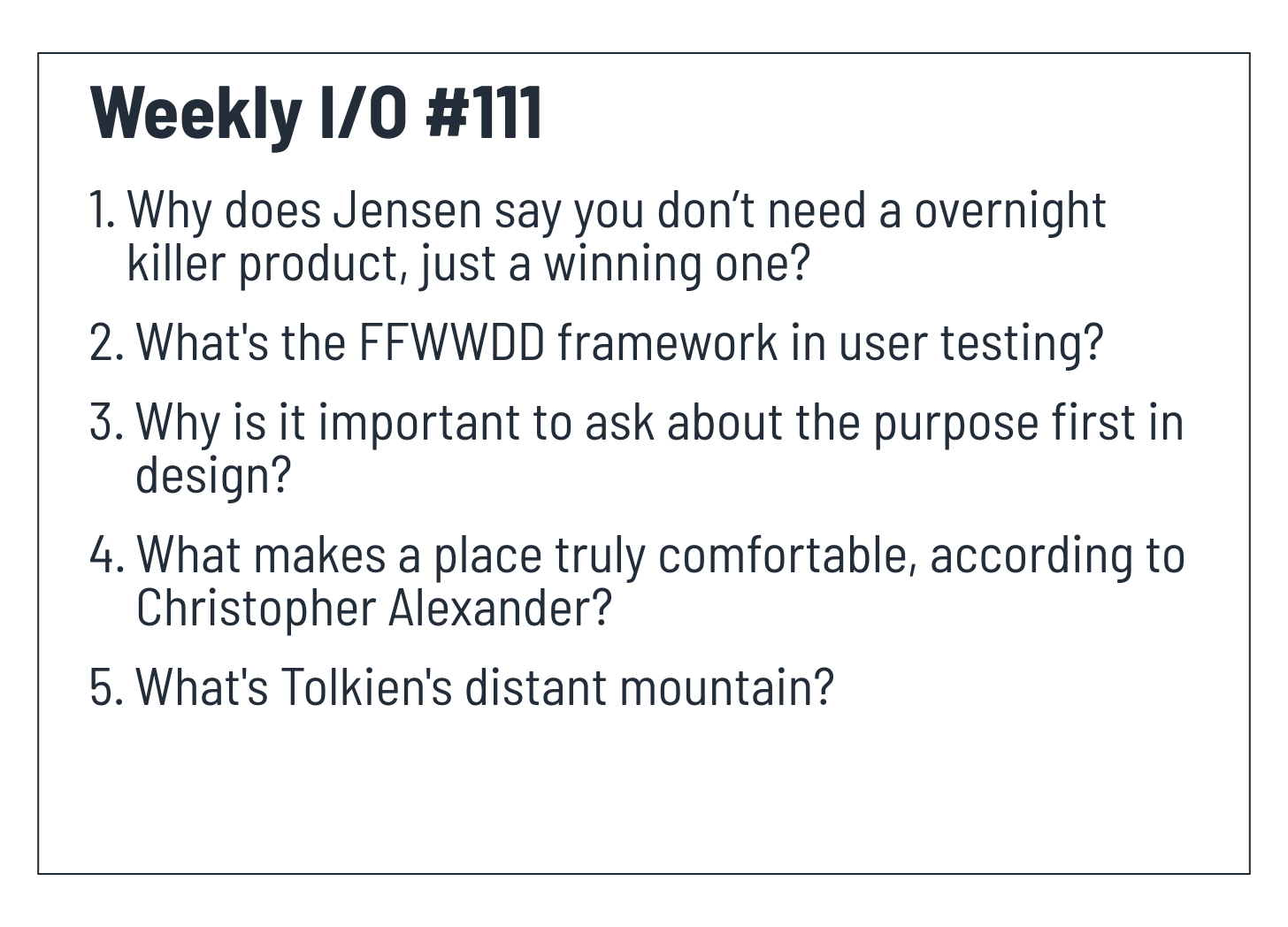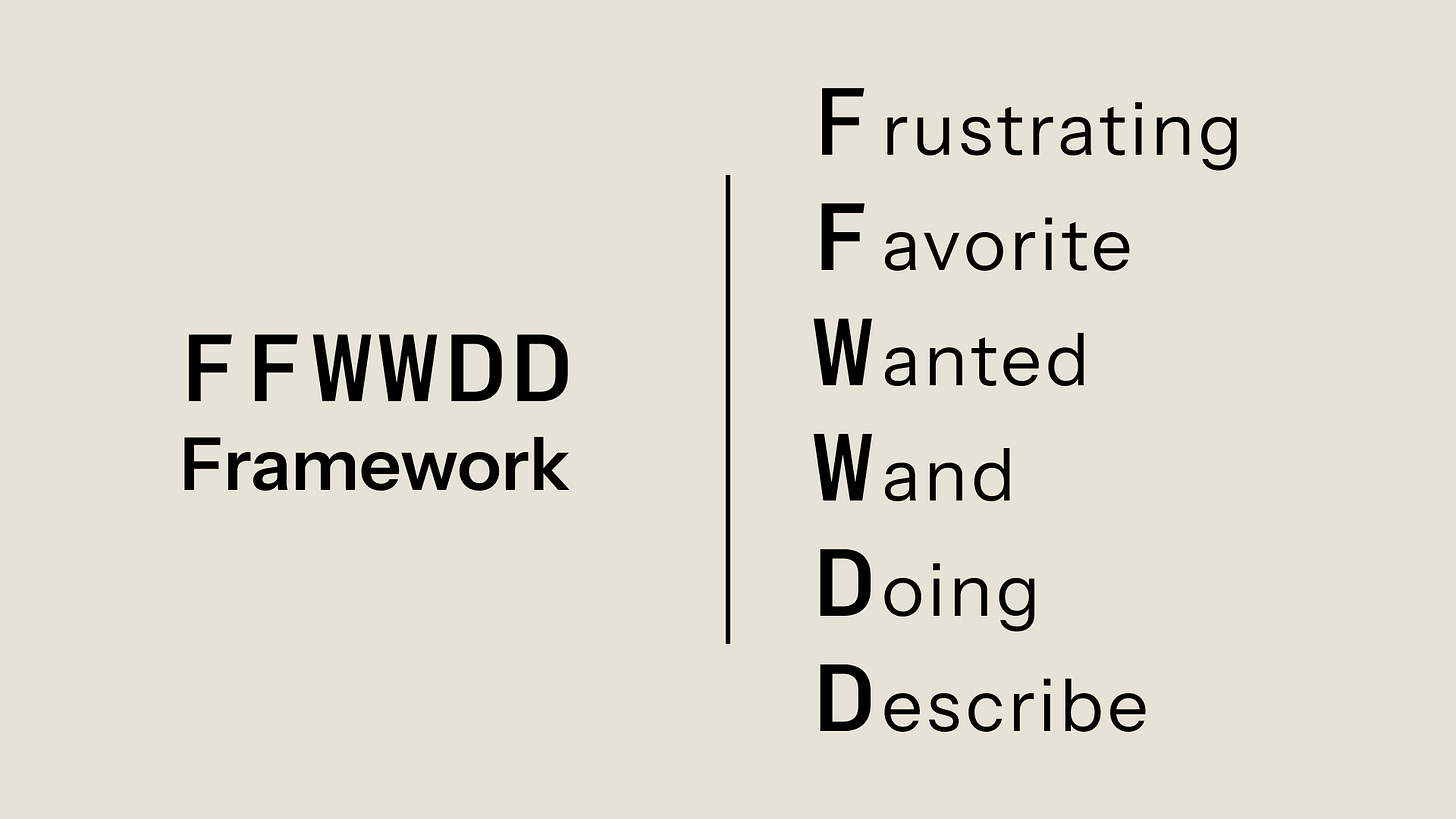Win today to play tomorrow, How to get honest feedback from users, First design principle
Weekly I/O #111: Win to Play Again, FFWWDD questions, Inner Contradiction in Design, Truly Comfortable, Distant Mountain
Heyo,
Apologies for the delay! I've been traveling in Indonesia and Singapore this week, but here’s your (belated) weekly update!
Additionally from this week, I created a standalone section for the weekly list of links I enjoyed.
As usual, please share with me any interesting things you’ve learned recently. Happy learning!
Input
Here's a list of what I learned this week.
1. You don't need to build a killer product overnight. You just need to build a winning product, and the goal of winning is so that you can play again.
Video: The Importance of Execution
From Jensen Huang in 2003:
You have to decide as a company, you have to decide as an engineering team or as an innovator, to say, "You know what? I don't need to change the world overnight. I'm going to change the world over the next 50 years. I don't need to build a killer product overnight. I just need to build a winning product."
And the goal of winning is so that you can play again. It's just like pinball. If you could just play well enough to get another game, you can be there for a long time. Most companies just need to realize that in fact this is a long road and that you can't build that perfect product.
So, once you do that, that you keep the project scope confined, you keep the project now simple, you have a long-term vision, your product definition is rather simple, you execute flawlessly on that because your people now can execute flawlessly on a simple plan and you come back and do it again.
Jensen's reflections remind me of two things:
Don't pay attention to those fastest to 100M ARR in history stories. Focus on learning from great business that endures the test of time. No hurry, no pause.
Remember, a finite game is played for the purpose of winning, an infinite game is for the purpose of continuing the play. Play the infinite game and be educated, not trained.
2. To learn what users truly felt and experienced, use the six-question framework FFWWDD to collect emotional, practical, and interpretive feedback in a structured way.
Book: The Art of Game Design
How to get honest and useful feedback from user testing your product in a systematic way?
Game designer Shawn Patton proposed the FFWWDD framework to get what the players truly feel when testing their games. It asks the following six questions:
What was the most frustrating moment or aspect of what you just played?
What was your favorite moment or aspect of what you just played?
Was there anything you wanted to do that you couldn't?
If you had a magic wand to wave, and you could change, add, or remove anything from the experience, what would it be?
What were you doing in the experience?
How would you describe this game to your friends and family?
You can remember the six questions with the mnemonic FFWWDD: Frustrating, Favorite, Wanted, Wand, Doing, and Describe.
The order of the questions matters. The first one lets players vent and release irritation before moving on. The second balances that by highlighting the peak of their enjoyment.
Questions three and four may seem similar, but they serve different roles. The third draws out small unmet desires while the fourth invites bold, outside-of-the-box answers.
Question five asks what the player thought their goal or role was, which may or may not match the designer's intention. The last question captures how players frame the whole experience when explaining it to others.
Together, these six prompts cover frustration, joy, unmet expectations, dreams, personal interpretation, and outside perspective. They form a simple but powerful lens for designers to understand how a game feels, not just how it functions.
Another book I found very useful for user interviews is The Mom Test.
3. Design succeeds when every element serves its purpose without inner contradictions. Therefore, designers must ask about the purpose first to avoid internal conflict in design.
Book: The Timeless Way of Building
Christopher Alexander suggested that things with the "The Quality Cannot be Named" feel alive, whole, comfortable, exact, free, egoless, and timeless. At the core of this quality is the absence of inner contradiction.
Inner contradictions destroy purpose. A device meant to save time but difficult to use has failed. A game that claims to be fun but structured to frustrate is fundamentally flawed.
Skilled designers resist the temptation to rationalize these flaws away. Instead, they hunt for contradictions relentlessly and eliminate them.
This requires asking fundamental questions. What is the purpose of the whole system? What is the purpose of each part? Does anything work against that purpose? If so, how can it be reshaped or removed?
For me, removing inner contradictions is the most essential design guidance because it forces clarity about purpose itself.
Any design can be brilliant for one purpose but terrible for another.
For example, complex interfaces fail for casual users, but are ideal when built for experts performing sophisticated tasks. Similarly, Inefficient approaches seem wasteful until you realize the purpose is creating something soulful rather than optimized. Therefore, purpose must come first, and the design must align with its purpose.
Moreover, inner contradiction not only kills design, but also undermines human fulfillment because "There can be no happiness if the things we believe in are different from the things we do."
4. Truly well-designed spaces share a unique quality: they make us feel deeply comfortable in ways that cannot be explained or shown off to others. This quality appears when every small detail is carefully arranged to support ease and presence.
Book: The Timeless Way of Building
Christopher Alexander spent his life studying why some spaces feel alive. He observed that truly well-designed spaces share a unique quality: comfort. It goes beyond beauty or display.
In The Timeless Way of Building, he described a scene:
Keep reading with a 7-day free trial
Subscribe to Weekly I/O to keep reading this post and get 7 days of free access to the full post archives.




